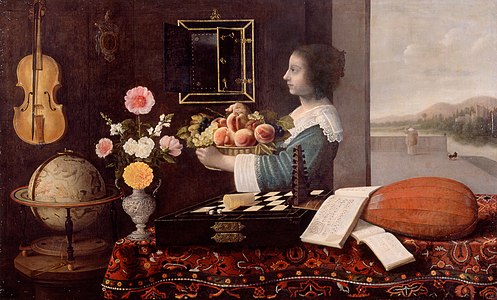| The Five Senses | |
|---|---|
| Summer | |
 | |
| Artist | Sebastian Stoskopff |
| Completion date | 1633 |
| Medium | Oil paint on canvas |
| Movement | Baroque painting Allegory Still life |
| Subject | Five Senses Summer |
| Dimensions | 114 cm × 186 cm (45 in × 73 in)[1] |
| Location | Musée de l'Œuvre Notre-Dame, Strasbourg |
| Accession | 1941 |
The Five Senses, also known as Summer is a signed and dated 1633 oil painting by Sebastian Stoskopff. It was painted at the height of the artist's stay in Paris from 1621 to 1640/1641. Together with its slightly wider pendant The Four Elements, or Winter (114 x 188 cm, or 45 x 74 in), it is today in the Musée de l'Œuvre Notre-Dame. Its inventory number is MBA 1695 ("MBA" stands for Musée des Beaux-Arts).[1][2]
The Five Senses is considered as Stoskopff's masterpiece, together with his Great Vanity, a work of very different design. The politician, painter, and writer Robert Heitz declared in his 1975 book on the history of painting in Alsace that The Five Senses surpasses the Great Vanity in audacity and that only Johannes Vermeer, several decades later, would again attain such harmony in the reconstruction of reality ("Le seul Vermeer, trente ou quarante ans plus tard, parviendra à cette harmonieuse reconstruction de la réalité"). The young woman of the painting, strangely immobile and unattractive, reminds Heitz of Piero della Francesca, or Paul Delvaux.[2] She is pictorially treated in the same way as the objects that surround her, as if she was just as inanimated, and part of the still life[3][4]
-
Another reproduction, with a different colour scheme
-
The Four Elements or Winter, the painting's pendant
- ^ a b Dupeux, Cécile (December 1999). Strasbourg - Musée de l'Oeuvre Notre-Dame. Paris: Éditions Scala. pp. 93–94. ISBN 2-86656-223-2.
- ^ a b Heitz, Robert (1978). La peinture en Alsace, 1050–1950. Strasbourg: Éditions des Dernières Nouvelles d'Alsace et Librairie Istra. ISBN 978-2-7165-0012-8. Retrieved 14 January 2021.
- ^ Bartha-Kovács, Katalin. "La Vanité aux cinq sens". academia.edu. pp. 314–315. Retrieved 14 January 2021.
- ^ Völlnagel, Jörg (2006). "Vanitas vs. optische Sensation Zu den Stilleben von Sebastian Stoskopff (1597–1657)*". Philologie im Netz (PhiN). pp. 21–22. Retrieved 14 January 2021.

